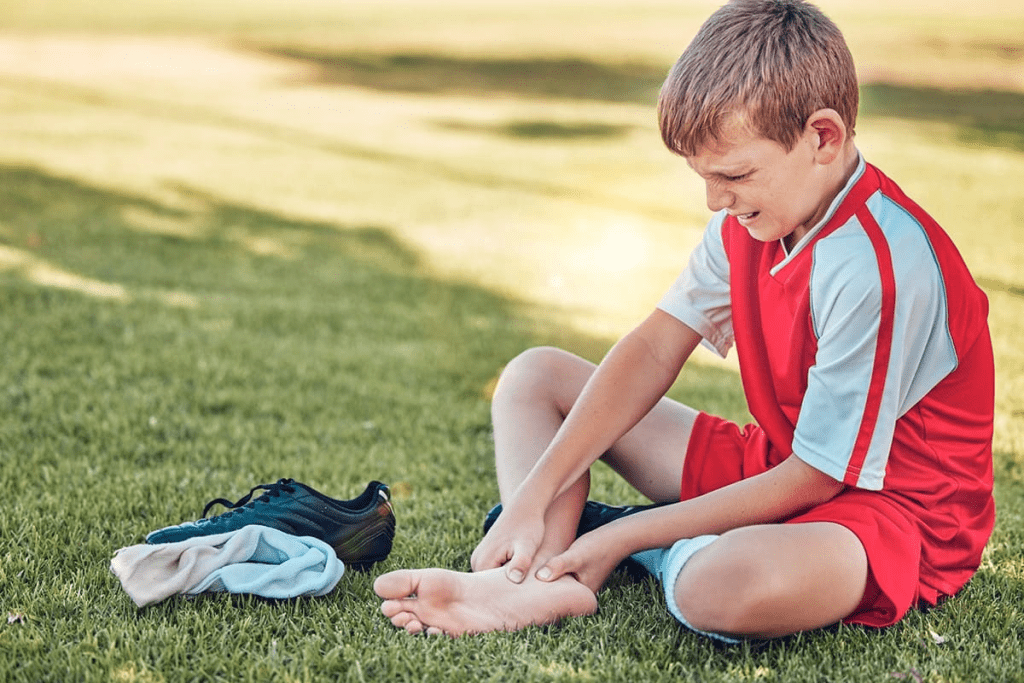Last Updated on November 13, 2025 by

Parents worry a lot about their kids’ health, and iron deficiency anemia is a big concern. The good news is that with the right treatment, like low iron supplements, kids can get better. But, the question is: how long does it take for iron pills to work?
Iron deficiency anemia is a common health issue in children. It’s often caused by not enough iron supplements for fatigue. How long it takes for iron levels to rise depends on several things. These include the cause and severity of the deficiency, how well the body absorbs iron, and if the treatment is followed correctly.
The answer varies, but usually, it takes a few months for iron levels to get back to normal. It’s important to keep a close eye on the child’s health during this time. This ensures the treatment is working well and the child stays healthy.
It’s important for parents and caregivers to know about iron deficiency in kids. This issue can affect a child’s energy, brain function, and growth. Knowing the causes and symptoms is key.
Several factors can lead to iron-deficiency anemia in children. These include:
Spotting these causes is vital. It helps in finding the right treatment. This might include iron tablets for low haemoglobin or other supplements.

The signs of iron deficiency can vary. But common ones include:
Seeing these signs early is important. It helps start treatment with pills with iron. This can greatly help a child’s health.
Some signs that show a need for iron supplements are:
Watching for these symptoms and talking to a doctor is essential. It helps figure out the best treatment.
When kids are found to have iron deficiency, parents often wonder how long it will take to see improvement. The journey to better iron levels has different stages. Iron supplements start to work in 2-4 weeks, but it can take longer for full recovery.

In the first 2-4 weeks, iron supplements start to show results. We see an increase in reticulocyte count, showing the bone marrow is making more red blood cells. Hemoglobin levels also start to go up, but bigger changes take longer.
Key indicators during this phase include:
By the 4-8 week mark, improvements are more noticeable. Hemoglobin levels keep rising, and ferritin levels start to come back, showing iron stores are being rebuilt. Kids often feel more energetic and healthy during this time.
Notable changes include:
Recovery from iron deficiency can take 2 to 3 months. It’s key to keep taking iron supplements as told by a doctor to fill up iron stores. Regular blood tests help track progress and adjust treatment if needed.
Knowing how long iron supplements take to work and being patient is important. It’s also vital to think about when to take iron supplements for better absorption, like on an empty stomach or with foods high in vitamin C.
By sticking to the treatment plan and making dietary changes, we can help our kids recover from iron deficiency and get back to full health.
When kids are found to have iron deficiency, parents often wonder how long it takes for iron pills to work. The time it takes for improvement can change based on several things. These include how bad the deficiency is, the child’s health, and the amount of supplement they take.
Kids with iron deficiency anemia might see their hemoglobin levels go up by about 1 g/dL every 2-3 weeks. This is a general rule, but it can change based on how well the child responds to the treatment and how bad the anemia is.
Ferritin levels, which show how much iron the body has, take longer to get back to normal. It can take several months of taking iron pills regularly to fully refill ferritin stores. It’s important to keep checking ferritin levels to see if the treatment is working and to adjust the dosage if needed.
The time it takes for improvement can vary a lot based on how bad the iron deficiency is. Kids with mild deficiency might see better hemoglobin levels in a few weeks. But kids with severe deficiency might take longer to start feeling better. For example:
As iron levels get better, parents will see their child’s energy and behavior improve. This can mean more activity, better focus, and a happier mood.
It’s key to keep giving iron supplements for the full time recommended. Stopping too soon can cause iron deficiency to come back.
The speed at which kids absorb iron can change a lot. Knowing what affects this is key for parents and doctors to make sure iron supplements work well.
Kids grow fast, and their iron needs change with age. Babies and toddlers need more iron because they grow so quickly. Growth spurts can increase the demand for iron, so it’s important to keep an eye on iron levels during these times.
What kids eat affects how well they absorb iron. Foods high in vitamin C, like citrus fruits and bell peppers, help iron absorption. But, drinking tea, coffee, or milk can make it harder. It’s a good idea to talk to a doctor about the best foods to eat to help iron.
Some health issues can make it hard for kids to absorb iron. For example, kids with celiac disease or stomach infections might have trouble. It’s important to manage these conditions well to help iron supplements work.
Getting kids to take iron supplements can be tough. Iron pills can upset their stomachs, making it hard to keep up with treatment. Parents can make it easier by giving the pills with something tasty that helps absorption.
By understanding and tackling these issues, we can make iron supplements more effective for kids. This helps them get better from iron deficiency faster.
Managing iron deficiency in kids is key. Knowing how to take iron supplements right is important. There are a few things to keep in mind to get the most out of them.
Iron supplements work best when taken on an empty stomach. This is because food can block iron absorption. But, some kids might feel sick if they take it on an empty stomach.
So, taking it with a little bit of food might help. Also, vitamin C can help your body absorb iron better. So, taking iron with orange juice or foods high in vitamin C is a good idea.
Some foods can help or hurt how well your body absorbs iron. Foods high in vitamin C, like citrus fruits, can help. But, foods high in calcium, like milk, can make it harder for your body to absorb iron.
It’s also best to avoid taking iron with tea or coffee. These drinks can make it harder for your body to absorb iron.
The right amount of iron supplements depends on age and how bad the deficiency is. Here’s what’s usually recommended:
But, kids with iron deficiency might need more. Always talk to a doctor about the right dose.
By following these tips, parents can help their kids get the most out of iron supplements. This can improve their iron levels and overall health.
As parents, we’re always looking for signs that iron supplements are working for our kids. It’s key to watch their progress closely. This ensures they get the most from their iron pills.
One clear sign is when kids start feeling better physically. They might:
Remember, these changes can take 2-4 weeks after starting iron supplements.
Kids on iron pills might also show changes in how they act and think. These can be:
These small changes are big signs that the iron is helping.
Lab tests are important to check if iron supplements are working. We look for:
By watching these signs and lab results, we can tell if our kids are doing well on iron therapy. If you’re worried, talk to your child’s doctor. They can help adjust the treatment if needed.
For kids to get better from iron deficiency, we need a full plan. This includes sticking to the treatment, using the right amount, and keeping an eye on progress. It’s key to know how long iron supplements take to work and when to see better hemoglobin levels.
Iron tablets can really help a child’s health, but it’s important to follow the dosage and how to take them. Knowing the best time to take iron supplements can make them work better and reduce side effects.
Parents and caregivers play a big role in helping kids get the most from iron therapy. They should know how to boost iron absorption and follow the best ways to give iron supplements. Regular check-ups with doctors are also important to see how the child is doing and make any needed changes.
With the right treatment and care, kids can get over iron deficiency and keep their iron levels healthy. This leads to better health and growth for them.
The time it takes for iron levels to improve in children varies. It depends on the severity of the deficiency and how well the supplement works. Generally, we see improvements in hemoglobin levels within 2-4 weeks. Complete recovery can take 2-3 months.
Signs that iron pills are working include more energy, better appetite, and less fatigue. We also see better concentration and mood. Lab tests, like hemoglobin and ferritin levels, show big improvements.
The dosage and frequency of iron supplements depend on the child’s age, weight, and iron deficiency level. Usually, they are taken once a day. A healthcare provider sets the dosage. It’s important to follow the recommended dosage and schedule for effective treatment.
For best results, take iron supplements on an empty stomach, 1-2 hours before meals. Foods high in vitamin C, like orange juice or strawberries, help iron absorption. But, foods high in calcium, like milk, can reduce it. Avoid giving iron supplements with tea or coffee, as they lower absorption.
Diet greatly affects iron absorption. Vitamin C-rich foods, like citrus fruits, help absorption. But, calcium-rich foods, like dairy, can block it. Also, tea and coffee can lower absorption, so avoid them with iron supplements or meals.
Recovery time varies with the severity of iron deficiency. Mild deficiency may improve quickly, in a few weeks. Moderate deficiency takes 2-3 months to recover. Severe deficiency can take even longer, often several months of treatment.
Visible improvements in energy and behavior can be seen in 4-8 weeks after starting iron supplements. But, the rate of improvement depends on the deficiency’s severity and the supplement’s effectiveness.
Ensuring compliance can be tough, but a routine helps. Give the supplement at the same time each day. Make it part of their daily routine. Use a pill box or reminder. Educate your child on the importance of taking their supplements as directed.
Subscribe to our e-newsletter to stay informed about the latest innovations in the world of health and exclusive offers!